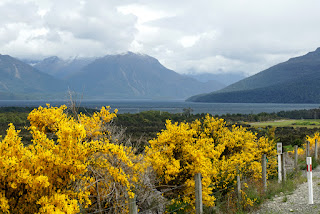November 27, 2022
November 27, 2022
We awoke to nice weather in Queenstown, New Zealand. Aimee and I are wondering if that will last the whole day. We drove fifteen minutes east to the Kawarau Bridge Historic Reserve. This is an old suspension bridge built in 1880 that spans the deep Kawarau River Gorge. It was built here where the gorge is narrowest during the Otago gold rush. The river gorge also was a film location for Lord of the Rings.
Today the bridge is most famous for being the site of the first commercial bungy jumping operation. It continues to this day. We watch one person after the other make the leap of faith hoping the over-size rubber band holds. Aimee really liked the sign for the toilets.
After this little bit of amusement, we returned our rental car to the local airport and then picked up the public bus back to our hotel. Conveniently the bus stops right in front of our hotel. For lunch Aimee insisted we eat at an Irish Pub named Pog Mahones. It is the only Gaelic words (Kiss my Ass) her Irish mother taught her. I am not surprised. Aimee and I shared a Beef and Guinness pie. Surprisingly it is our first time ever eating it. Of course I washed it down with a real Guinness draft.
We spent a couple hours walking the lake and doing some shopping. We watched as the historic TSS Earnslaw left the harbor for a lake cruise. Queenstown is known as the Adventure Capital of the World. We pass dozens of shops hawking every imaginable adrenaline tour. The other half of the stores sell adventure gear.
At 2:30PM we mosey over to the Ultimate Hikes Center. We signed up for something completely different. We are going to do another Great Walk, supposedly the best in New Zealand. But this time it is for five days staying at backcountry lodges. This Milford Track is a 33.5-mile trail that runs from Te Anau through Fiordlands National Park to the Milford Sound Fjord. We are told the weather forecast is colder and rainier than normal. Curses! Where is Global Warming when you need it.
We spend the rest of the afternoon organizing our gear. It is a logistical concern. We have our hiking gear which will get very wet. We have dry clothes to change into on arrival at each lodge. This all has to fit inside our daypacks. We also chose some clothes that will be sent ahead for the last day touring Milford Sound. And finally all the rest needs to be packed inside our luggage for storage at our hotel while gone. We hope we sorted everything correctly.
We awoke to nice weather in Queenstown, New Zealand. Aimee and I are wondering if that will last the whole day. We drove fifteen minutes east to the Kawarau Bridge Historic Reserve. This is an old suspension bridge built in 1880 that spans the deep Kawarau River Gorge. It was built here where the gorge is narrowest during the Otago gold rush. The river gorge also was a film location for Lord of the Rings.
Today the bridge is most famous for being the site of the first commercial bungy jumping operation. It continues to this day. We watch one person after the other make the leap of faith hoping the over-size rubber band holds. Aimee really liked the sign for the toilets.
After this little bit of amusement, we returned our rental car to the local airport and then picked up the public bus back to our hotel. Conveniently the bus stops right in front of our hotel. For lunch Aimee insisted we eat at an Irish Pub named Pog Mahones. It is the only Gaelic words (Kiss my Ass) her Irish mother taught her. I am not surprised. Aimee and I shared a Beef and Guinness pie. Surprisingly it is our first time ever eating it. Of course I washed it down with a real Guinness draft.
We spent a couple hours walking the lake and doing some shopping. We watched as the historic TSS Earnslaw left the harbor for a lake cruise. Queenstown is known as the Adventure Capital of the World. We pass dozens of shops hawking every imaginable adrenaline tour. The other half of the stores sell adventure gear.
At 2:30PM we mosey over to the Ultimate Hikes Center. We signed up for something completely different. We are going to do another Great Walk, supposedly the best in New Zealand. But this time it is for five days staying at backcountry lodges. This Milford Track is a 33.5-mile trail that runs from Te Anau through Fiordlands National Park to the Milford Sound Fjord. We are told the weather forecast is colder and rainier than normal. Curses! Where is Global Warming when you need it.
We spend the rest of the afternoon organizing our gear. It is a logistical concern. We have our hiking gear which will get very wet. We have dry clothes to change into on arrival at each lodge. This all has to fit inside our daypacks. We also chose some clothes that will be sent ahead for the last day touring Milford Sound. And finally all the rest needs to be packed inside our luggage for storage at our hotel while gone. We hope we sorted everything correctly.

















.jpg)





















.jpg)














